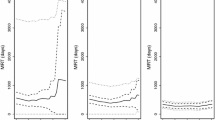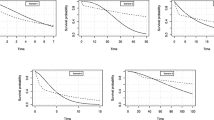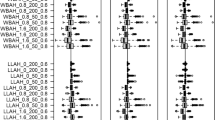Abstract
Estimation and inference in time-to-event analysis typically focus on hazard functions and their ratios under the Cox proportional hazards model. These hazard functions, while popular in the statistical literature, are not always easily or intuitively communicated in clinical practice, such as in the settings of patient counseling or resource planning. Expressing and comparing quantiles of event times may allow for easier understanding. In this article we focus on residual time, i.e., the remaining time-to-event at an arbitrary time t given that the event has yet to occur by t. In particular, we develop estimation and inference procedures for covariate-specific quantiles of the residual time under the Cox model. Our methods and theory are assessed by simulations, and demonstrated in analysis of two real data sets.



Similar content being viewed by others
References
Andersen P, Gill R (1982) Cox’s regression model for counting processes: a large sample study. Ann Stat 10(4):1100–1120
Cheng K (1984) On almost sure representation for quantiles of the product limit estimator with applications. Sankhyā Indian J Stat Ser A 46(3):426–443
Cheng S, Fine J, Wei L (1998) Prediction of cumulative incidence function under the proportional hazards model. Biometrics 54(1):219–228
Dabrowska D, Doksum K (1987) Estimates and confidence intervals for median and mean life in the proportional hazard model. Biometrika 74(4):799–807
Efron B, Tibshirani R (1998) An Introduction to the Bootstrap. CRC Press LLC, Boca Raton
Epanechnikov V (1969) Non-parametric estimation of a multivariate probability density. Theory Porb Appl 14(1):153–158
Fleming T, Harrington D (2005) Counting Processes and Survival Analysis. Wiley, Hoboken, NJ
Gelfand A, Kottas A (2003) Bayesian semiparametric regression for median residual life. Scand J Stat 30(4):651–665
Jackson J, Musoke P, Fleming T, Guay L, Bagenda D, Allen M, Nakabiito C, Sherman J, Bakaki P, Owor M, Ducar C, Deseyve M, Mwatha A, Emel L, Duefield C, Mirochnick M, Fowler M, Mofenson L, Miotti P, Gigliotti M, Bray D, Mmiro F (2003) Intrapartum and neonatal single-dose nevirapine compared with zidovudine for prevention of mother-to-child transmission of HIV-1 in Kampala, Uganda: 18-month follow-up of the HIVNET 012 randomised trial. The Lancet 362:859–868
Jeong J, Jung S, Costantino J (2008) Nonparametric inference on median residual life function. Biometrics 64(1):157–163
Jung S, Jeong J, Bandos H (2009) Regression on quantile residual life. Biometrics 65(4):1203–1212
Kalbfleisch J, Prentice R (2002) The Statistical Analysis of Failure Time Data. Wiley, Hoboken, NJ
Kaplan E, Meier P (1958) Nonparametric estimation from incomplete observations. J Am Stat Assoc 53(282):457–481
Klein J, Moeschberger M (2003) Survival Analysis: Techniques for Censored and Truncated Data. Springer, New York
Ma Y, Yin G (2010) Semiparametric median residual life model and inference. Can J Stat 38(4):665–679
Parzen M, Wei L, Ying Z (1994) A resampling method based on pivotal estimating functions. Biometrika 81(2):341–350
Ramlau-Hansen H (1983) Smoothing counting process intensities by means of kernel functions. Ann Stat 11(2):453–466
Yandell B (1983) Nonparametric inference for rates with censored survival data. Ann Stat 11(4):1119–1135
Yang S (1999) Censored median regression using weighted empirical survival and hazard functions. J Am Stat Assoc 94(445):137–145
Ying Z, Jung S, Wei L (1995) Survival analysis with median regression models. J Am Stat Assoc 90(429):178–184
Author information
Authors and Affiliations
Corresponding author
Additional information
Acknowledgment of Priority:
After our paper (Crouch et al. 2015) was accepted and appeared online in May 2015, we became aware that some content of our paper overlaps with an article recently published by Lin et al. (doi: 10.1007/s10985-013-9289-x). The majority of the overlap occurs in Section 2 of both papers. This is perhaps unsurprising, as these sections present the earliest stages of our derivations, both of which are based on a fundamental relationship between residual time and the survival function and utilize the Cox proportional hazards framework. Beyond these sections, the papers are more divergent. Specifically, we present a “plug-in” variance estimator in addition to resampling methods, provide a calculation of confidence bands, consider different methods for comparing two covariate-specific quantiles of residual time, perform different simulations (notably varying sample size in addition to other parameters), use different examples, and include graphics to illustrate results of both simulations and examples.
Electronic supplementary material
Below is the link to the electronic supplementary material.
Appendix
Appendix
We restate conditions A–D of Andersen and Gill (1982) with minor modification as in Fleming and Harrington (2005):
-
A.
The time \(\tau \) is such that \(\int _0^{\tau }\lambda (t)dt<\infty \).
-
B.
For \(\varvec{S}^{(j)}, j=0,1,2\), there exists a neighborhood \(\mathscr {B}\) of \(\varvec{\beta }\) and scalar, vector, and matrix functions \(s^{(0)}\), \(\varvec{s}^{(1)}\), and \(\varvec{s}^{(2)}\) defined on \(\mathscr {B} \times [0,\tau ]\) such that, for \(j=0,1,2\),
$$\begin{aligned} \sup _{t \in [0,\tau ],\varvec{\beta }\in \mathscr {B}}||\varvec{S}^{(j)} (\varvec{\beta },t)-\varvec{s}^{(j)}(\varvec{\beta },t)|| \rightarrow 0 \end{aligned}$$in probability as \(n\rightarrow \infty \).
-
C.
There exists \(\delta >0\) such that
$$\begin{aligned} \sqrt{n} \sup _{i,t}|\varvec{Z}_i|Y_i(t)I (\varvec{\beta }^{\mathrm{T}}\varvec{Z}_i > -\delta |\varvec{Z}_i|) \rightarrow 0 \end{aligned}$$in probability as \(n\rightarrow \infty \).
-
D.
Let \(\mathscr {B}\) and \(\varvec{s}^{(j)},j=0,1,2\) be defined as in Condition B and \(\varvec{e}\) and \(\mathbf {v}\) as in Sect. 2. Then for all \(\varvec{\beta } \in \mathscr {B}\) and \(t \in [0,\tau ]\):
$$\begin{aligned} \varvec{s}^{(1)}(\varvec{\beta },t)=\frac{\partial }{\partial \varvec{\beta }}s^{(0)}(\varvec{\beta },t), \;\;\; \varvec{s}^{(2)}(\varvec{\beta },t)=\frac{\partial ^2}{\partial \varvec{\beta }^2}s^{(0)}(\varvec{\beta },t), \end{aligned}$$\(s^{(0)}(\cdot ,t)\), \(\varvec{s}^{(1)}(\cdot ,t)\), and \(\varvec{s}^{(2)}(\cdot ,t)\) are continuous function of \(\varvec{\beta } \in \mathscr {B}\), uniformly in \(t \in [0,\tau ]\), \(s^{(0)}\), \(\varvec{s}^{(1)}\), and \(\varvec{s}^{(2)}\) are bounded on \(\mathscr {B} \times [0,\tau ]\); \(s^{(0)}\) is bounded away from zero on \(\mathscr {B} \times [0,\tau ]\), and the matrix \(\varvec{\Sigma }\) (as defined in Sect. 2) is positive definite.
Proof
(Theorem 1) The proof for (1) follows directly from the established convergence of the individual estimators and the application of the continuous mapping theorem. Likewise for (3), where the consistency of the kernel-estimated baseline hazard has already been established (Ramlau-Hansen 1983; Yandell 1983). Therefore only (2) requires a detailed proofl.
We begin with two equations: one based on the true values,
and one based on the estimated values,
Taking the differences between the left- and right-hand sides of both equations yields
Examining the left-hand side first, we have
where the approximation is due to Taylor’s expansion. Examining the right-hand side, we have
again using Taylor’s approximation. Combining everything gives us the expression
Rearranging yields the approximation
From Fleming and Harrington (2005) we know that
so we can rewrite the overall approximation as
We can also perform a substitution, setting \(u=t+v\), and integrating with respect to v. This yields the approximation
Applying results from Fleming and Harrington (2005) about the asymptotic variance of \(\varvec{\widehat{\beta }}\) and martingales, we have:
where
Based on the consistency of the estimators used in this formulation, we have the asymptotic result \(\sqrt{n}(\widehat{\theta }(t,q|\varvec{Z}) - \theta (t,q|\varvec{Z})) \rightarrow _d N(0,V(t))\), where
and
\(\square \)
Proof
(Corollary 1) The proof for (1) follows directly from the established convergence of the individual estimators and the application of the continuous mapping theorem. Likewise for (3), where the consistency of the kernel-estimated baseline hazard has already been established (Ramlau-Hansen 1983; Yandell 1983). Therefore we need only prove (2) in detail.
From the proof of Theorem 1, we have
where
In order to calculate \(\mathrm {Var}(\widehat{\theta }(t_1,q_1|\varvec{Z}_1)- \widehat{\theta }(t_2,q_2|\varvec{Z}_2))\), we note that
Now

where \(\eta _{\mathrm {min}}=\min \{ \theta (t_1,q_1|\varvec{Z}_1) + t_1 ,\theta (t_2,q_2|\varvec{Z}_2) + t_2\}\) and \(t'=\max \{ t_1 , t_2\}\).
So, combining the above with results from Theorem 1 and taking into account the consistency of the estimators used in this formulation, we have the asymptotic result
where
\(\square \)
Rights and permissions
About this article
Cite this article
Crouch, L.A., May, S. & Chen, Y.Q. On estimation of covariate-specific residual time quantiles under the proportional hazards model. Lifetime Data Anal 22, 299–319 (2016). https://doi.org/10.1007/s10985-015-9332-1
Received:
Accepted:
Published:
Issue Date:
DOI: https://doi.org/10.1007/s10985-015-9332-1




